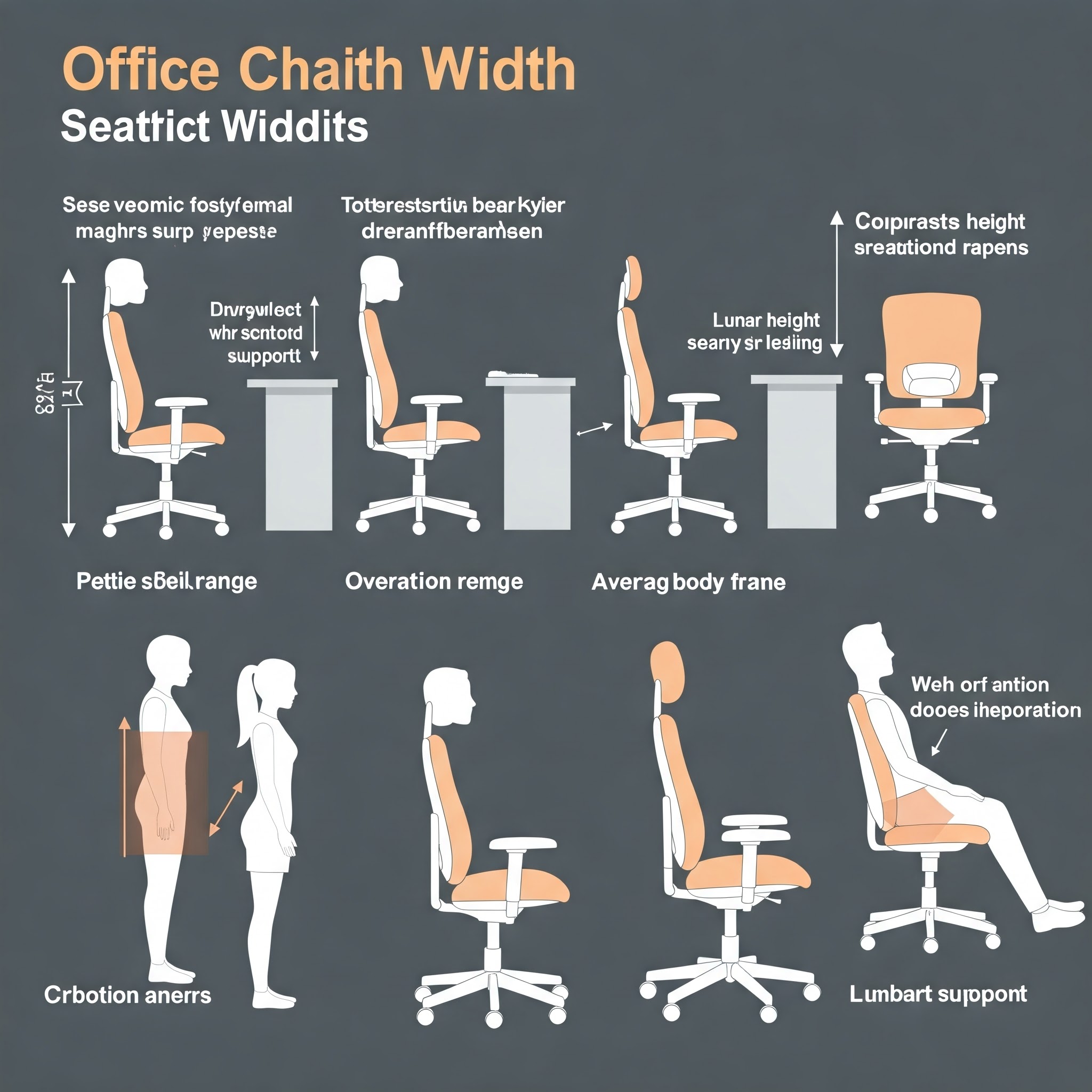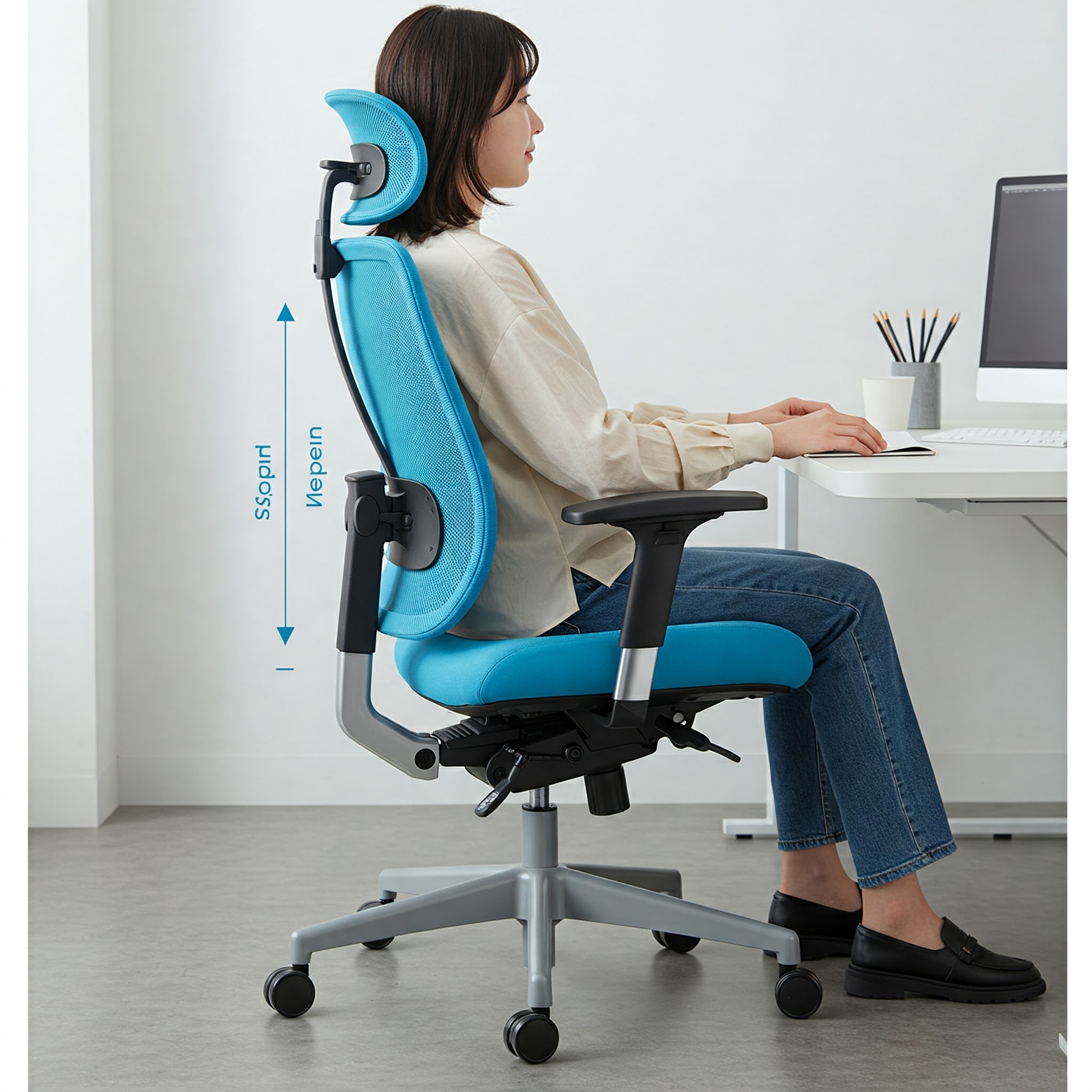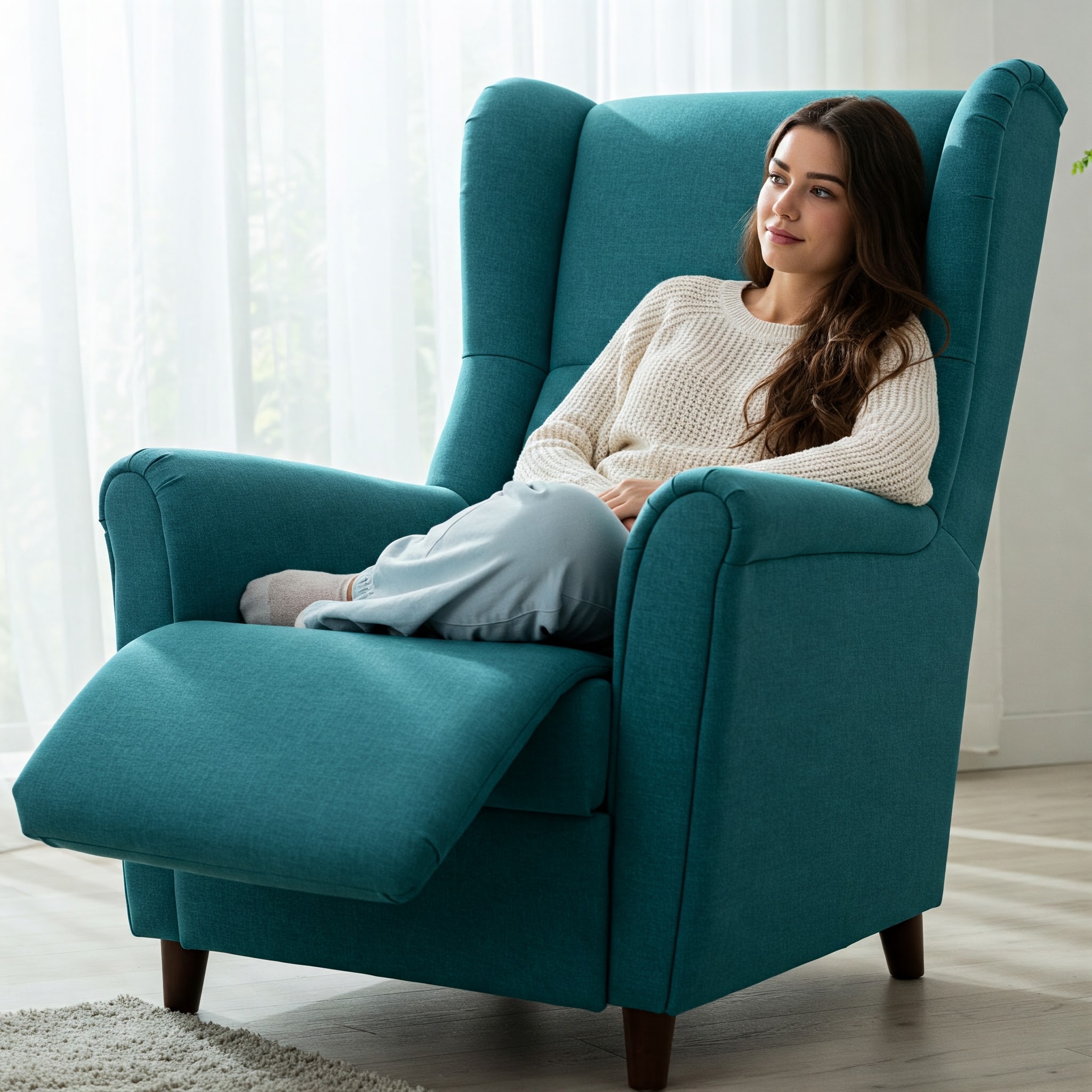Finding the perfect office chair can feel like searching for a needle in a haystack. Among the many factors to consider, office chair width often gets overlooked – yet it’s one of the most crucial elements for ensuring proper comfort and support during those long work hours.
Whether you’re setting up a home office or upgrading your workspace, understanding the importance of office chair width can make all the difference between a chair that feels just right and one that leaves you uncomfortable and distracted. In fact, according to a study by the National Institute for Occupational Safety and Health, proper seating dimensions can significantly reduce work-related discomfort and boost productivity by up to 17%.
In this comprehensive guide, we’ll dive deep into everything you need to know about office chair width – from standard measurements to special considerations for different body types and workspace configurations. By the end, you’ll be equipped with the knowledge to choose an office chair that fits you perfectly!
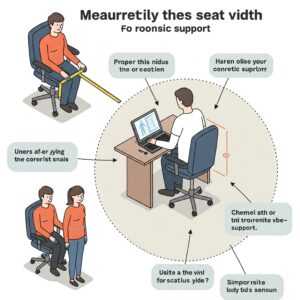
Why Office Chair Width Matters
The width of your office chair impacts far more than just how much space it takes up in your room. Let’s explore why this dimension deserves your attention:
Comfort and Body Support ✅
Perhaps the most obvious reason office chair width matters is comfort. A chair that’s too narrow can cause your hips and thighs to feel compressed, leading to discomfort and even pain during extended sitting periods. Moreover, an adequate width ensures proper weight distribution, reducing pressure points and supporting healthy circulation.
According to ergonomics experts at Cornell University, proper seat width allows your body to shift position naturally throughout the day, which is essential for reducing fatigue and preventing muscular strain.
Posture and Alignment ✅
When your chair width is appropriate for your body type, it helps maintain proper spinal alignment. A too-narrow seat might force you to perch on the edge, compromising your posture, while an excessively wide seat might not provide the necessary lateral support to keep your spine aligned.
Dr. Mark Vettraino, a chiropractor specializing in workplace ergonomics, notes that “proper seat width encourages a neutral posture where the spine maintains its natural curves, significantly reducing the risk of developing chronic back problems.”
Movement Freedom ✅
A well-sized chair allows you the freedom to move and adjust your position throughout the day. This movement is crucial for maintaining blood flow and reducing the stiffness associated with prolonged sitting.
Research published in the Journal of Occupational Health indicates that micro-movements while seated can reduce the negative impacts of sedentary work – and adequate chair width is essential to facilitate these natural adjustments.
Workspace Efficiency ✅
Beyond personal comfort, office chair width also affects how efficiently you can use your workspace. A chair that’s too wide might make it difficult to navigate tight spaces or fit properly under your desk, while one that’s too narrow might leave you feeling unstable or unsupported.
Standard Office Chair Width Measurements
Understanding standard measurements gives you a baseline for comparison when shopping for your perfect chair. Here’s what you should know about typical office chair width dimensions:
Seat Width
The seat width refers to the actual sitting surface where your hips and thighs rest. Standard office chairs typically have seat widths ranging from 17 to 22 inches (43-56 cm). This measurement is critical as it directly impacts your comfort.
| Chair Type | Typical Seat Width Range | Best For |
|---|---|---|
| Standard Task Chair | 17-19 inches | Average build users |
| Executive Chair | 20-22 inches | Larger users, luxury comfort |
| Petite/Compact Chair | 16-17 inches | Smaller users, tight spaces |
| Big & Tall Chair | 22-30 inches | Users with larger frames |
Total Chair Width
The total width includes the seat plus armrests and any side mechanisms. This dimension typically ranges from 22 to 30 inches (56-76 cm) for standard office chairs. Total width is particularly important when considering space constraints in your office.
According to the Business and Institutional Furniture Manufacturers Association (BIFMA), a minimum clearance of 36 inches (91 cm) is recommended for chairs in workspaces to allow for proper movement and access.
Armrest Width Considerations
Armrests add to the total office chair width and typically extend 2-3 inches on each side of the seat. Many modern ergonomic chairs feature adjustable armrests that can be moved inward or outward to accommodate different body types and preferences.
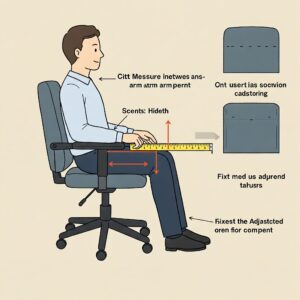
How to Measure for the Right Office Chair Width
Finding your ideal office chair width isn’t just about following general guidelines – it’s about finding what works specifically for your body and workspace. Here’s how to determine the right measurements:
For Your Body Type ✅
- Sit on a flat surface with good posture
- Measure the width of your hips and thighs at their widest point
- Add 1-2 inches (2.5-5 cm) on each side for comfortable movement
- This total gives you your minimum recommended seat width
For example, if your hip measurement is 16 inches, your ideal seat width should be at least 18-20 inches to provide adequate support without feeling constricted.
For Your Workspace ✅
- Measure the available width in your workspace where the chair will be used
- Account for necessary clearance (ideally 36 inches total as recommended by BIFMA)
- Consider desk height and design – some chairs with wider armrests may not fit under standard desks
Ergonomics consultant Emily Richards emphasizes that “your chair should allow you to sit comfortably close to your desk without the armrests colliding with the desk edge, which often forces users into awkward, non-ergonomic positions.”
Office Chair Width for Different Body Types
Everyone’s body is unique, and office chair width needs vary accordingly. Let’s break down some specific considerations for different body types:
Petite Frames
If you have a smaller frame, standard office chairs might feel too large, causing you to perch forward and lose back support. Consider these guidelines:
- Ideal seat width: 16-18 inches
- Look for chairs specifically marketed for petite users
- Adjustable armrests that can be positioned closer together
- Shallower seat depth to allow proper back support
Average Builds
For those with average body types, standard office chairs typically work well, but paying attention to width still matters:
- Ideal seat width: 18-20 inches
- Standard task chairs usually provide appropriate dimensions
- Focus on other adjustability features once width requirements are met
Larger Frames
People with larger builds often struggle with standard office chairs that are simply too narrow for comfort:
- Ideal seat width: 21-30 inches
- Look for chairs specifically labeled as “big and tall” or “wide”
- Weight capacity should match your needs (typically 300-500 lbs)
- Reinforced frames for durability and stability
The Ergonomics Center of North Carolina recommends that “larger individuals should prioritize chairs with seat widths at least 22 inches wide to prevent the discomfort and health issues associated with inadequate support.”
Top Office Chairs Based on Width Requirements
Different situations call for different chair widths. Here are some top recommendations based on specific width needs:
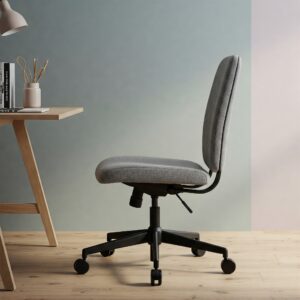
For Narrow Spaces
If you’re working with limited room, these chairs offer comfort without taking up excessive space:
- Herman Miller Sayl Chair – With a seat width of 18 inches and a minimal, breathable design, this chair provides ergonomic support while working well in compact spaces.
- HON Volt Task Chair – At just 17.5 inches of seat width and 26 inches total width, this budget-friendly option fits well in tight corner setups while maintaining good support.
- SIDIZ T50 Home Office Desk Chair – With its 19-inch seat width and sleek profile, this chair offers a good balance of support and space efficiency.
For Average Needs
These chairs hit the sweet spot for most users with standard width requirements:
- Steelcase Gesture Chair – Features a 20-inch seat width and highly adjustable design that accommodates various body types and sitting positions.
- Autonomous ErgoChair Pro – With a 20-inch seat width and 29-inch total width including armrests, this chair provides ample support for average users.
- Branch Ergonomic Chair – Offering a 19.5-inch seat width, this chair combines comfort, adjustability, and reasonable pricing.
For Wider Support
For those needing extra width, these chairs deliver without compromising on ergonomics:
- Steelcase Leap Plus – Specifically designed for larger users, with a 22.75-inch seat width and 500-pound weight capacity.
- Herman Miller Aeron Size C – The largest size of the popular Aeron chair offers a 21-inch seat width with exceptional ergonomic support.
- La-Z-Boy Delano Big & Tall Executive Chair – With its impressive 24-inch seat width and plush padding, this chair provides generous proportions for maximum comfort.
Comparison of Popular Office Chairs by Width
To help you visualize how different chairs compare in terms of width, here’s a detailed comparison table:
| Chair Model | Seat Width | Total Width (w/ Arms) | Weight Capacity | Price Range | Best For |
|---|---|---|---|---|---|
| Herman Miller Aeron (Size A) | 18.25″ | 25.75″ | 300 lbs | $$$$ | Petite to average builds |
| Herman Miller Aeron (Size B) | 19.75″ | 27″ | 350 lbs | $$$$ | Average builds |
| Herman Miller Aeron (Size C) | 21″ | 28.25″ | 350 lbs | $$$$ | Larger builds |
| Steelcase Leap | 19.25″ | 27″ | 400 lbs | $$$$ | Average builds |
| Steelcase Leap Plus | 22.75″ | 31″ | 500 lbs | $$$$$ | Larger builds |
| HON Ignition 2.0 | 20″ | 26″ | 300 lbs | $$ | Average builds |
| SIDIZ T50 | 19″ | 28″ | 275 lbs | $$$ | Average builds |
| Autonomous ErgoChair Pro | 20″ | 29″ | 350 lbs | $$ | Average to larger builds |
| Branch Ergonomic Chair | 19.5″ | 26″ | 300 lbs | $$ | Average builds |
| La-Z-Boy Delano | 24″ | 32″ | 400 lbs | $$$ | Larger builds |
Transform Your Workday with the Perfect Chair! 🪑✨
→ Ready to experience true comfort? These carefully selected chairs offer the perfect width for every body type and workspace. Click on any highlighted chair to check current pricing and availability. Your body will thank you for making this important investment in your health and productivity!
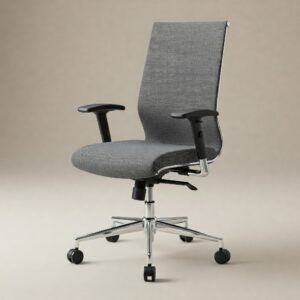
Common Office Chair Width Problems and Solutions
Even with careful consideration, you might encounter some challenges related to office chair width. Let’s address common issues and their solutions:
Problem: Chair Too Narrow ❌
Signs:
- Hip and thigh compression
- Inability to shift position comfortably
- Feeling like you’re “spilling over” the edges
Solutions:
- Look for chairs specifically designed for wider support
- Consider removing or adjusting armrests if they’re causing width issues
- Invest in a seat cushion extension (though this is a temporary fix rather than ideal solution)
Dr. Jacob Teitelbaum, a specialist in chronic pain, notes in his research published in the Journal of Chronic Fatigue Syndrome that “sitting in too-narrow chairs can exacerbate pain conditions by restricting blood flow and causing muscle tension.”
Problem: Chair Too Wide ❌
Signs:
- Difficulty reaching armrests comfortably
- Lack of lateral support leading to poor posture
- Chair won’t fit properly in your workspace
Solutions:
- Look for chairs with adjustable armrests that can be moved inward
- Add lumbar support cushions to improve back positioning
- Consider ergonomic chairs designed for petite frames
Problem: Chair Doesn’t Fit Under Desk ❌
Signs:
- Unable to sit close enough to your work surface
- Armrests collide with desk edge
- Forced to sit in awkward positions
Solutions:
- Opt for chairs with height-adjustable or fully removable armrests
- Consider armless chair designs for very tight spaces
- Adjustable-height desks can help accommodate wider chairs
Office Chair Width and Ergonomics: The Bigger Picture
While office chair width is crucial, it’s just one piece of the ergonomic puzzle. Here’s how width considerations fit into overall ergonomic chair design:
The Ergonomic Trifecta
For truly comfortable seating, three key dimensions must work together:
- Width – Provides proper hip and thigh support
- Depth – Ensures back support without cutting into the backs of the knees
- Height – Allows feet to rest flat on the floor with thighs parallel to the ground
According to the Occupational Safety and Health Administration (OSHA), when these three dimensions are properly matched to your body, you significantly reduce the risk of developing musculoskeletal disorders associated with prolonged sitting.
Dynamic Sitting
Modern ergonomics emphasizes the importance of movement throughout the day. An appropriate office chair width supports what experts call “dynamic sitting” – the ability to shift positions naturally.
The American Physical Therapy Association recommends choosing a chair width that allows for position changes while maintaining support, noting that “static postures, even if initially ‘correct,’ become problematic when held for extended periods.”
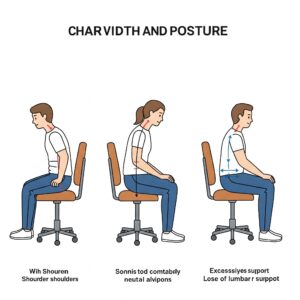
Office Chair Width for Special Situations
Beyond standard office environments, specific situations may have unique office chair width requirements:
Home Office Considerations
Home offices often have more space constraints than corporate environments. Consider these factors:
- Multi-purpose spaces may benefit from chairs with narrower profiles
- Measure doorways and pathways if you need to move your chair frequently
- Consider how the chair fits aesthetically in your home environment
Gaming Chairs
Gaming chairs often feature a distinctive bucket seat design that impacts effective width:
- Racing-style gaming chairs typically have raised sides that reduce usable seat width
- Consider the actual flat sitting surface rather than total width
- Look for gaming chairs with adjustable or removable bolsters if width is a concern
Collaborative Workspaces
In environments where chairs need to be moved frequently or used by multiple people:
- Opt for chairs with moderate widths (18-20 inch seats) to accommodate various users
- Consider armless designs to reduce total width and improve mobility
- Prioritize chairs with easy adjustability features
How Office Chair Width Affects Productivity and Health
The connection between office chair width and your wellbeing goes deeper than momentary comfort:
Productivity Impact ⚡
Research from the Workplace Health and Safety journal shows that proper seating dimensions, including width, can:
- Reduce fidgeting and distraction
- Decrease time spent adjusting position
- Lower fatigue during long work sessions
- Improve focus and concentration
A study tracking productivity before and after ergonomic chair upgrades found an average 17.5% increase in task completion rates when workers received properly-sized chairs.
Long-term Health Considerations 🔋
The long-term health implications of improper office chair width shouldn’t be underestimated:
- Inadequate width can restrict blood flow to the legs
- Compressed tissues may lead to nerve impingement
- Poor positioning can cause musculoskeletal imbalances
- Discomfort leads to compensatory postures that strain the spine
Dr. Mark Benden, Director of the Ergonomics Center at Texas A&M University, emphasizes that “the accumulative effect of slightly too narrow seating over years of office work can contribute significantly to the development of chronic pain conditions.”
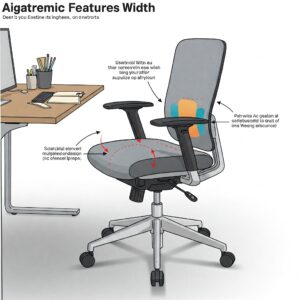
Future Trends in Office Chair Width Design
The world of office furniture continues to evolve. Here are some emerging trends in office chair width design:
Adaptable Width Technology
Newer chair models are beginning to feature seats that can automatically adjust width based on:
- User weight distribution
- Pressure mapping technology
- Temperature-responsive materials that conform to body shape
Personalization Revolution
The future of office seating may include:
- 3D body scanning for perfectly sized chair recommendations
- Modular components that can be swapped out as needs change
- Custom-printed chair components tailored to individual measurements
Inclusive Design Movement
Furniture manufacturers are increasingly embracing designs that:
- Accommodate a wider range of body types without stigma
- Offer adjustability ranges that serve 95% of the population (versus the traditional 80%)
- Use universal design principles to create chairs that work for diverse users
Find Your Perfect Office Chair Width: Action Steps
Ready to find your ideal chair? Follow these steps to ensure you select the right office chair width for your needs:
- Measure twice, buy once – Take accurate measurements of both your body and your workspace
- Test before investing – Whenever possible, try chairs in person before purchasing
- Check return policies – Even with careful planning, you might need to make a change
- Consider future needs – Think about how your requirements might evolve over time
- Look beyond marketing – Focus on actual measurements rather than vague descriptions like “oversized” or “slim profile”
Upgrade Your Work Experience Today! 🏆🛒
→ Don’t settle for discomfort another day! The perfect office chair width can transform your work experience from painful to productive. Explore our recommended chairs above to find your ideal match. Remember, proper support isn’t a luxury—it’s essential for your health and performance!
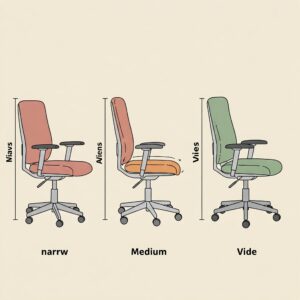
Conclusion
Office chair width may seem like a small detail in the grand scheme of office equipment, but its impact on your comfort, health, and productivity is profound. By understanding your specific needs and the options available, you can make an informed choice that supports your wellbeing for years to come.
Whether you need a compact chair for a small apartment workspace or a generously proportioned seat for all-day comfort, the perfect chair is out there. Take the time to find it – your body will thank you!
Remember that the best chair is one that fits you so well that you hardly notice it throughout your workday. When you can focus on your work rather than your discomfort, you’ve found the right match.
Take Action for Your Comfort Now! 🚀💺
→ The right office chair width can make all the difference between a painful workday and a productive one. Don’t wait to improve your workspace ergonomics! Click on any of our recommended chairs above to find your perfect fit today. Your back, hips, and productivity will thank you!
More FAQ
❓ What is the standard width of an office chair?
✅ Most office chairs have a seat width between 18 to 22 inches, which suits average body sizes. Some wider models are designed for extra comfort or larger users…
❓ How do I choose the right office chair width?
✅ To choose the right width, ensure there’s at least an inch of space on each side of your hips when seated. It should feel snug but not restrictive…
❓ Are wider office chairs better for comfort?
✅ Wider office chairs can enhance comfort, especially during long work hours or for larger individuals. However, they may not fit smaller spaces as easily…
❓ Can office chair width affect posture?
✅ Yes, a chair that’s too narrow may restrict movement, while one too wide can reduce proper back support. Balanced width helps maintain ergonomic posture…
❓ Is chair width important for small home offices?
✅ Absolutely. In compact spaces, a narrower chair helps save room without compromising comfort, making it ideal for minimalist or home office setups…
Recommended for You:
- 10 Premium Leather Office Executive Chair Options for Professional Success in 2025
- 10 Best Desk Chair with Flip Up Arms for Maximum Workspace Flexibility in 2025
- 10 Best Office Chair for Hip Pain: Top-Rated Picks to Eliminate Discomfort & Boost Comfort in 2025
Disclaimer: This article contains affiliate links. If you purchase products through these links, we may earn a small commission at no additional cost to you.

